Last year at Sunny Meadows Flower Farm we expanded our production from four acres to ten. Being in the city of Columbus, Ohio, and already using all of our own land, we had to consider other properties to expand production. We currently rent the lot adjacent to ours, but have no contract and are afraid of being kicked off some day, so we know we need something with a little more security as we continue to think about expanding perennials and greenhouses.
We looked for farm fields for sale, but most were zoned for commercial development as, unfortunately, farmers can make more money selling their land to developers than to other farmers. After looking at one property, we decided renting was more feasible for us. We sent an email out to all the people we knew in the plant industry in our area just in case anyone knew of farm land that was transferring hands without going on the market, or had any extra space we could use. Luckily, one of those people responded and said he had a piece of land we could rent, he remembered being “young and land poor.”
After some deliberation, we decided to make the investment in expansion and signed a 5-year contract with Decker’s Nursery for an 8-acre plot. I will refer to our farm as the “home farm” and this rented piece of land as “Decker’s farm”. Our goal was to be able to focus more energy on cover cropping and resting land, as we have been working the soil at our home farm really hard, multi-cropping most years, and mainly using cover crops in the winter or cramming them in between cash crops when possible. This new land would allow us more intentional, longer resting in preparation for the next year’s crops. We actually had a whole field rested all summer with a cover crop of sorghum-sudangrass, soy, and daikon, prepping the area where the dahlias are going to go this year.
We were already finished with our crop plan for the home farm for the year when we signed the contract, so we decided to focus on increasing a few crops on the new land to see how things would grow over there. We knew we could sell more sunflowers, zinnias, and celosia, so we started by increasing those crops, planning to both direct seed and transplant at the new farm. We got soil tests done, applied organic granular soil amendments, and were ready for planting; now we just needed the equipment to get the job done.
A truckload of zinnias from the new land, ready to go in the box truck back to the home farm for bouquets.
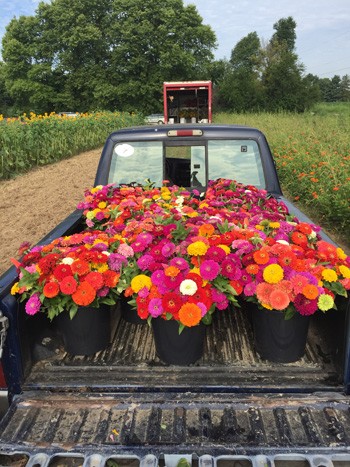
After driving our tractor on the road over there, we knew that we didn’t want to do that too often. It takes 10 minutes to get to the Decker’s farm by car, but on the tractor, it was about 23 minutes and there is a busy multi-lane intersection on the way. We also didn’t have a truck or trailer big enough for transporting our large tractor, so we knew more equipment purchases were in our future both for farm use and logistical purposes. We ended up buying a used Ford 2120 from Decker’s as part of our contract, so we weren’t adding a tractor to his equipment shed. We also bought a ride-behind cultivator from him (pictured in our article about mechanical cultivation in the August 2016 issue of Growing for Market), eliminating the need to transport our cultivating tractor back and forth. We purchased a used 3-point 4-row Planet Jr. seeder, two tillers, and three vehicles- one to get the crew there, a box truck to get the flowers home, and an old truck for on-farm harvest. We got an equipment loan through Farm Credit Services for the big items, but had to absorb all the costs for small tools and everything else we would need for two locations.
We knew this was our chance to apply all the systems we’ve set up and really focus on efficiency; it was almost like starting a new farm with everything we’ve learned along the way. The rows were planned to be much longer there, 400’ as opposed to the 150’ beds we have at the home farm. Before we started planting, we discovered the county was going to be putting drainage in the swale running through the property. We will have better drainage, but on the other hand now we have a diagonal through the middle of the field, cutting through some of our planned long, straight rows. We decided to just go with it, and make all the rows as long as possible, meaning that each field was different in length, from 500’ down to 100’. This year we standardized the bed lengths as much as possible to make crop planning and irrigation simpler, so we rounded the length of the beds down to be 400’, 350’, 300’, 250’, and so on down to 100’. In the smaller beds, we are planting crops that we need less of, so we have intentionally placed the larger scale items like sunflowers, zinnias, and celosia in the largest beds. This made crop planning much easier than trying to adapt the number of flats to fit with crazy spacing.
Expansion enables the author to plant long rows of crops she needs a lot of, like sunflowers.
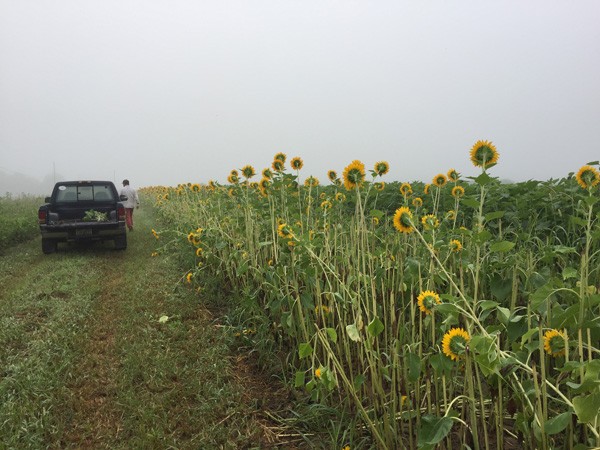
Irrigation was another challenge we faced at the new farm. Luckily, there is plenty of water we could access, but the pressure was so high we could not connect a garden hose, let alone drip tape. We went from using garden hose and drip at the home farm, to 4” pipe and 100 gallons a minute at the Decker’s farm, transported with 25-foot metal pipes. We decided to go with the sprinkler system Decker’s had set up at their farm so we could use their equipment before purchasing our own.
We tried a traveling sprinkler, but instead decided to go with the smaller system he was using in his potted plant production. These were a set of sprinklers that had Netafim nozzles on the top of a fiberglass riser, connected with poly tubing, and set with concrete into 1-gallon pots so they could be movable yet secure. This irrigation system worked better for us since we mechanically cultivate, leaving tangled drip tape out of the equation. We ended up bringing this system back to the home farm, and plan to use even less drip tape in the future. We are also increasing our use of foliar feeding, using a Dosatron to meter the fertilizer through the overhead sprinklers, since the rows at Decker’s are so long and we don’t have a tractor-mounted sprayer yet.
There is hortonova netting stretched over this big bed keeping the celosia upright. All images courtesy of Gretel Adams.
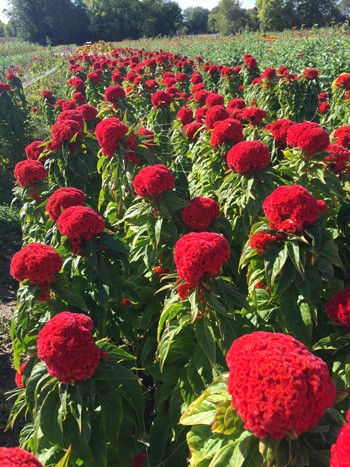
This field was in conventional grain before we took over, but the soil tests were good, so the biggest issue we ran into was weed pressure. When we told the farmer that we were using organic methods he said, “good luck with that,” so we knew we were in for a treat. By the time the drainage was done and we got the field tilled up, we were already a few weeks behind in our plan of what was going over there, so we started planting right away. Some of the early beds were lost in the weeds before we established good systems over there, but we knew there might be some loss during the transition. For the beds planted later in the season, we got our standard bed prep done and didn’t have as many problems with weeds, using our mechanical cultivation equipment & methods (see my August 2016 GFM article for details).
There were definitely some logistical challenges trying to figure out how to be two places at once. Our team had to divide and conquer, splitting harvest into two parts, orchestrating how many people we needed at each place, and having someone in charge during two separate harvests. There were some other team challenges like figuring out availability in both places, and being proactive about projections of needs when you can’t just run out to the field to harvest a couple more celosia heads to finish a bunch. We got more of that figured out by the end of the season. And this year we had some more time to think about the plan, and are meeting with an Excel spreadsheet guy to work on our inventory management systems. I would love to see a system that spit out a harvest list so I don’t have to recreate it each day.
With increased production, we knew we would have to increase sales to accommodate all these blooms. We added a second grocery distribution center and signed up to sell through The Bouqs, a farm-direct bouquet delivery service. Both of those required boxes, so we added that to our processing tasks and moved the farm stand out of the barn to accommodate the storage space. Most of what we were growing at the Decker’s farm ended up being for bouquets and grocery bunches, with all the specialty and greenhouse crops, as well as perennials here at the home farm. Our goal is to continue to separate production with the bulk of the annuals planted over at Decker’s as we increase our covered space and perennial production at home.
Making bouquets with flowers from the new land. Access to more land has enabled the author to increase production.
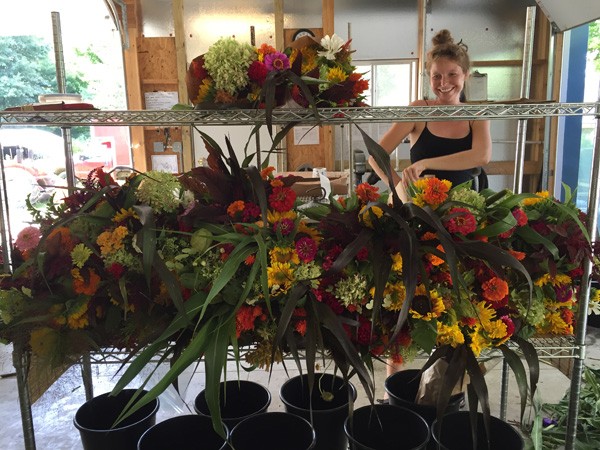
Sometimes we get asked, “How big is too big?” I think that is all relative, the answer depends on how hard you want to work, how many employees you want to have, how much you want to manage, and many other factors (kids, health, market demand, competition, land access and quality, etc.). Right now demand is growing in our area, so we will grow to help supply it. Shipping flowers is even potentially in our future, and/or an online shopping cart. Something about our business changes every year, which makes it kind of crazy, but also keeps it interesting. Winter is our time to research and grow as people, work on leadership skills, brainstorm efficiencies, and plan the season. Spring is the most exciting time of year, when all those things we’ve been thinking about all winter come to life.
With changes there will be growing pains, but part of farming is learning from your failures and being willing to adapt. We do a lot of assessing- crunching numbers and probably overthinking each step, but ultimately go with our gut and what we think we are capable of with the help of our amazing team. You won’t know what the right decision is until you make one and execute, then you can decide whether or not it worked for you, or how you can improve if necessary. Just being open to change and some creative problem solving has helped us find our way, so we encourage our team to help us brainstorm options. Always ask lots of questions of your mentors to see if there are lessons already learned that can guide you.
Gretel & Steve Adams own Sunny Meadows Flower Farm, where they will host the fall conference for the ASCFG (Association of Specialty Cut Flower Growers) on Sunday, October 8th. They will also be a part of the tours offered during the annual floriculture conference, Cultivate on Saturday, July 15th. Both dates will include a tour at both locations. And still some dahlia tubers available on their site for any last-minute orders.

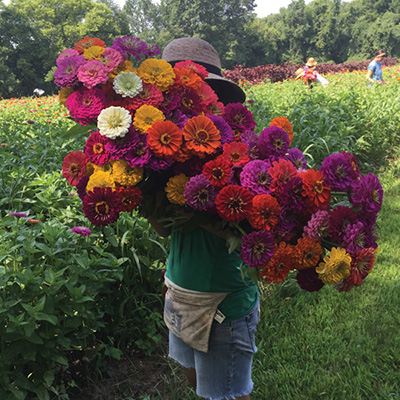
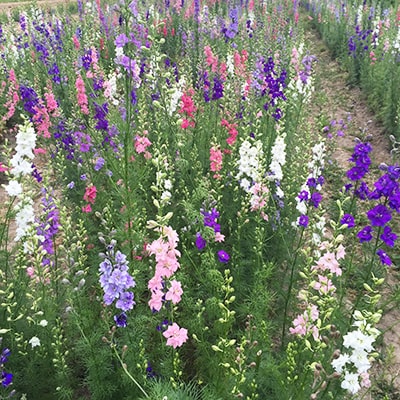
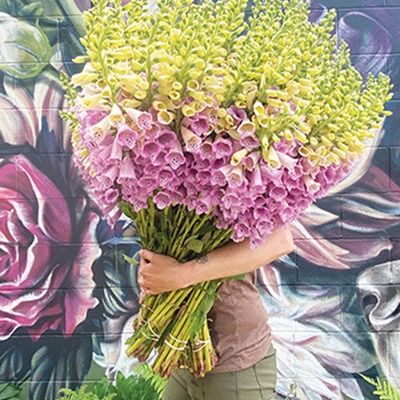
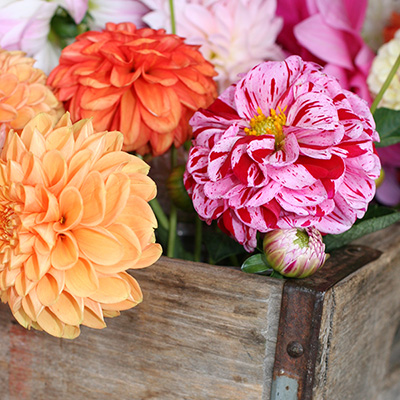


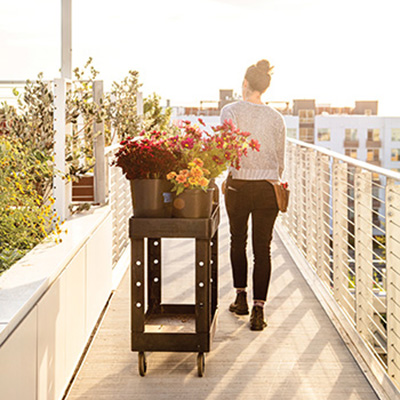
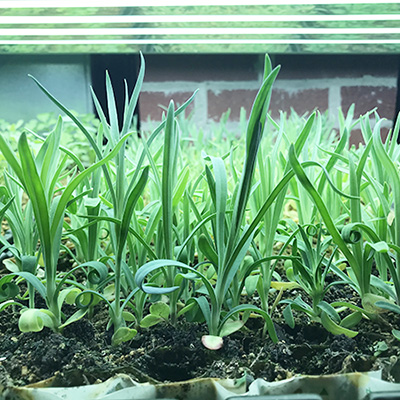
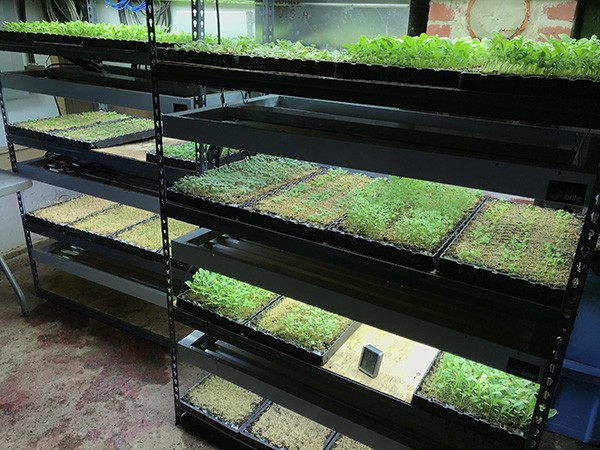 Have you ever lost precious seedlings in your greenhouse to frost? How about tossing a flat or two out due to heat stress or a missed watering? Or better still, stared at a tray of seeds that won’t germinate, with smoke coming out of your ears, because you’re sure someone (not you!) mis-watered them at a critical moment? Have you ever shrugged to yourself reading the growing instructions on a seed packet that says “Germinates best at 70 Fahrenheit” while standing in your 85-90 degree greenhouse? You’ve started to look into a germination chamber to solve some of these issues, but they look pricey and have limitations like not being able to handle as many flats as you’d like to start at once.
Have you ever lost precious seedlings in your greenhouse to frost? How about tossing a flat or two out due to heat stress or a missed watering? Or better still, stared at a tray of seeds that won’t germinate, with smoke coming out of your ears, because you’re sure someone (not you!) mis-watered them at a critical moment? Have you ever shrugged to yourself reading the growing instructions on a seed packet that says “Germinates best at 70 Fahrenheit” while standing in your 85-90 degree greenhouse? You’ve started to look into a germination chamber to solve some of these issues, but they look pricey and have limitations like not being able to handle as many flats as you’d like to start at once.
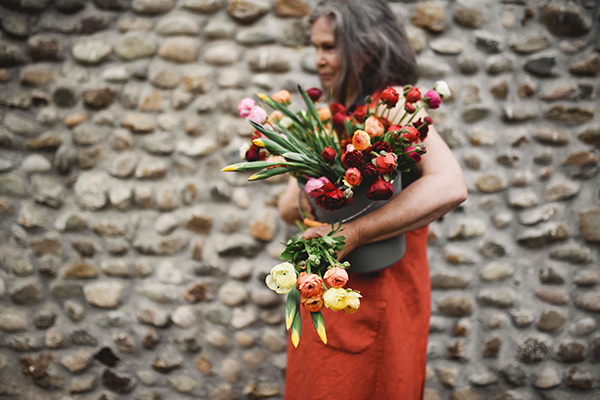 Lorna Jackson started flower farming intensely relatively later in life at Ninebark Farm on a century-old hayfield in Metchosin at the southern tip of Vancouver Island in British Columbia, Canada. Now 64, she plans to continue into her 70s. To keep going, she makes adaptations to ease the toll on her body.
Lorna Jackson started flower farming intensely relatively later in life at Ninebark Farm on a century-old hayfield in Metchosin at the southern tip of Vancouver Island in British Columbia, Canada. Now 64, she plans to continue into her 70s. To keep going, she makes adaptations to ease the toll on her body.
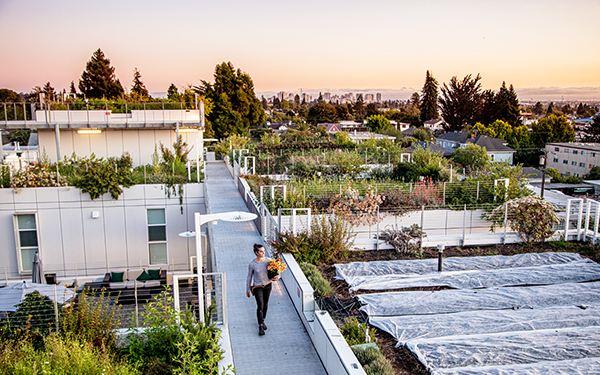 I own and operate Bluma Flower Farm, currently located on a rooftop in downtown Berkeley, California. Going into this year my plan was to try to replicate what I did the year before, one of Bluma’s best years yet. This would have been the first year I didn’t make any big changes. But then the pandemic hit and, of course, like many other businesses, I had to pivot and find ways to survive.
I own and operate Bluma Flower Farm, currently located on a rooftop in downtown Berkeley, California. Going into this year my plan was to try to replicate what I did the year before, one of Bluma’s best years yet. This would have been the first year I didn’t make any big changes. But then the pandemic hit and, of course, like many other businesses, I had to pivot and find ways to survive. 
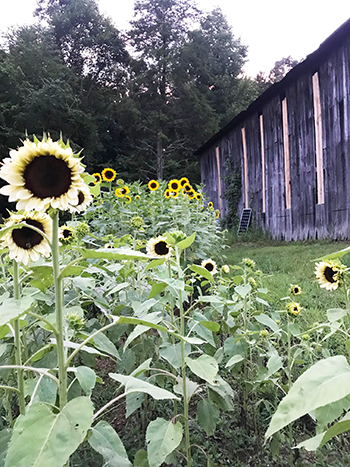 After spending years working in a corporate environment and managing key performance indicators, I was excited about the prospect of farming without the overhead of data analysis. Gone would be the management by objectives, the need to determine return on investment and other such details on which the corporate world revolves.
After spending years working in a corporate environment and managing key performance indicators, I was excited about the prospect of farming without the overhead of data analysis. Gone would be the management by objectives, the need to determine return on investment and other such details on which the corporate world revolves.
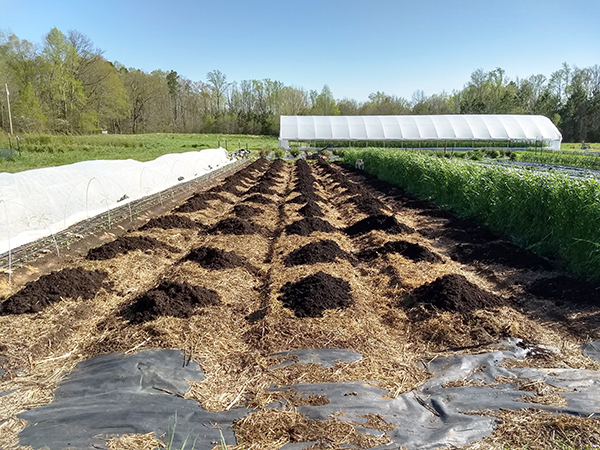 My wife, Megan, and I grow cut flowers on half an acre of a twelve-acre property in Hurdle Mills, NC. We are in the heart of tobacco country. When we bought our property in 2013, our sales contract stipulated that the farmer had the right to harvest that year’s tobacco crop. Based on our best guesses, that marked at least the 100th consecutive year of tobacco/wheat rotations on this property. The farmer was kind enough to disc in the tobacco stubble after the harvest.
My wife, Megan, and I grow cut flowers on half an acre of a twelve-acre property in Hurdle Mills, NC. We are in the heart of tobacco country. When we bought our property in 2013, our sales contract stipulated that the farmer had the right to harvest that year’s tobacco crop. Based on our best guesses, that marked at least the 100th consecutive year of tobacco/wheat rotations on this property. The farmer was kind enough to disc in the tobacco stubble after the harvest.
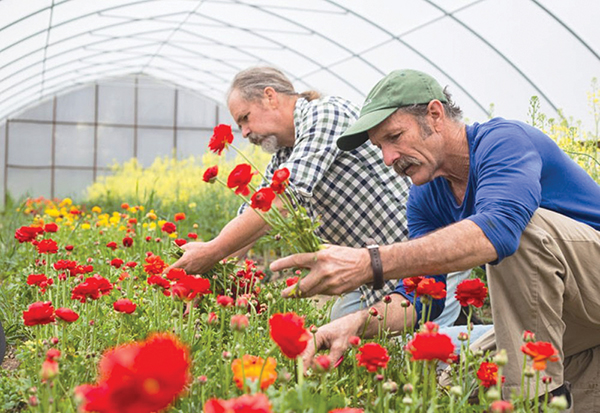 During the COVID era my usual travels have been curtailed. So, I got to thinking about what farms I had visited in the past that I knew pretty well, where a simple phone call could possibly stand-in for a proper on-farm interview and tour. First to my mind was Dripping Springs Garden, an oasis of natural and man-made beauty that is the life’s work of a good friend of mine, Mark Cain, and his farm partner, Michael Crane.
During the COVID era my usual travels have been curtailed. So, I got to thinking about what farms I had visited in the past that I knew pretty well, where a simple phone call could possibly stand-in for a proper on-farm interview and tour. First to my mind was Dripping Springs Garden, an oasis of natural and man-made beauty that is the life’s work of a good friend of mine, Mark Cain, and his farm partner, Michael Crane.
 There are a lot of things we can’t grow in our climate and soil here in zone 4a in Starbuck, Minnesota. But I’m especially envious of some of the woody perennials I see other farmers growing – even at farms just a few hours south of us. As a result, I’m always looking for new woodies to try that are hardy here.
There are a lot of things we can’t grow in our climate and soil here in zone 4a in Starbuck, Minnesota. But I’m especially envious of some of the woody perennials I see other farmers growing – even at farms just a few hours south of us. As a result, I’m always looking for new woodies to try that are hardy here. 
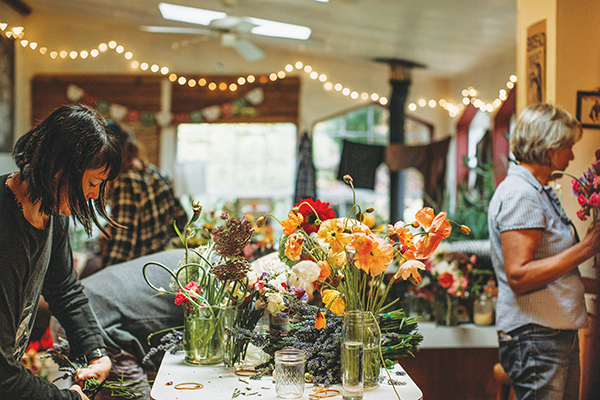 Weddings are a huge opportunity for local flower farmers, especially with the growing awareness of and demand for seasonal, sustainable flowers. And, if there is one time that people really want special flowers, it’s at their weddings.
Weddings are a huge opportunity for local flower farmers, especially with the growing awareness of and demand for seasonal, sustainable flowers. And, if there is one time that people really want special flowers, it’s at their weddings.